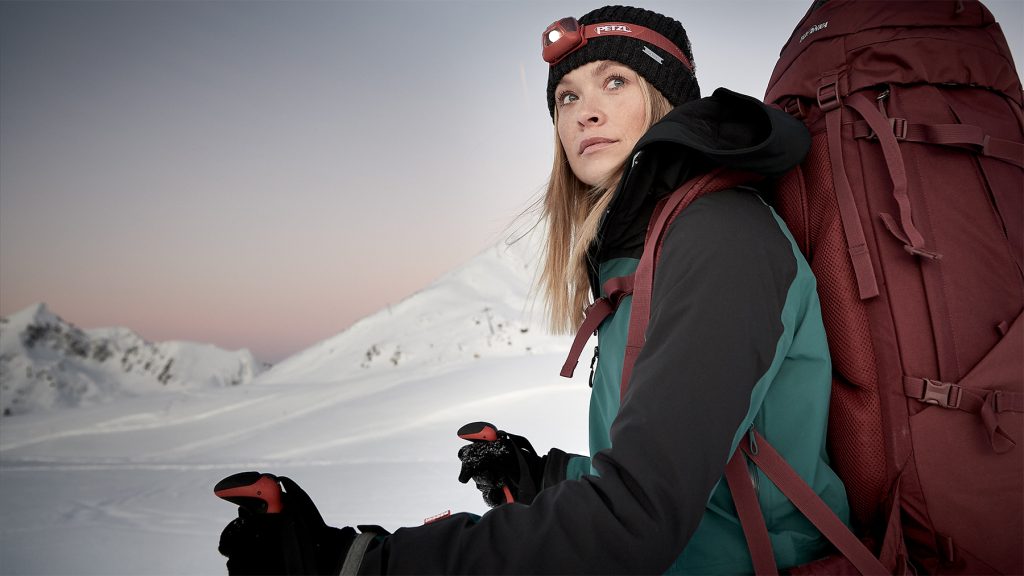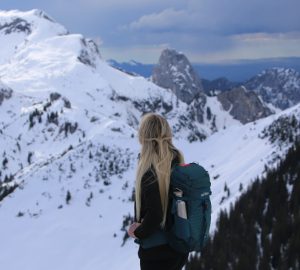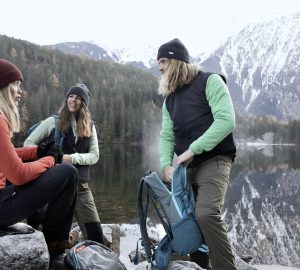When hiking in the mountains in spring or even in summer, you may suddenly come across snowfields from the previous winter. Many hiking enthusiasts underestimate the danger posed by these old snowfields. But slipping here can be life-threatening. We explain to you how to cross old snowfields.
Old snow fields can be very dangerous! If you fall and start to slide, even a seemingly harmless slope with a gradient of 30 degrees can be your undoing – especially if there are rocks or steep terrain at the bottom of the snowfield.
That’s because it can become extremely difficult to brake once you’ve picked up speed while sliding. At an incline of 40 degrees, the speed becomes almost as high as in free fall. This makes tour planning, the right equipment, and knowing the right technique all the more important.
Where and when do old snowfields appear?
Old snowfields last quite a long time, especially on north-facing slopes and in shady valleys. At altitudes above 2000 meters, they can even remain all year round. You should keep this in mind when planning your tour. In order not to take unnecessary risks, it is advisable to avoid routes on which larger fields of old snow are to be expected. Webcams as well as asking hut keepers can help you to correctly assess the situation and, if necessary, switch to a south-facing route.

The right backpack for every tour
At Tatonka you will find the right backpack for every tour. Whether for your planned long-distance hike or a day trip with via ferrata.
The time of day makes a big difference when traversing old snowfields. In the morning, the snow is frozen hard from the cold of the night. Then, the danger of slipping and falling is particularly high. If the upper part of the snow cover is not somewhat softened by the sun and heat radiation, it is almost impossible to set safe footholds. Without technical equipment, you should definitely hike around such a snowfield. If this is not possible, it is advisable to abort the tour. Note that a snowfield can also start sliding from below.
In the afternoon, on the other hand, the snow may be thawed. It is soft, wet and above all heavy. Even then, there is an increased risk of falling when you cross a snowfield. In addition, walking in thawing snow is extremely strenuous and slippery. Keep this in mind when planning your tour.
Also interesting: Safety on the Mountain – Getting emergency help in the mountains
Crossing old snowfields: Footwear and equipment
Even with the most careful tour planning, it can happen that you unexpectedly encounter a snowfield while hiking in the mountains. In order to weigh up whether it is safe to cross, it depends not only on the condition of the snow, but also on your equipment. As with hiking in general, the right footwear is crucial. Hiking boots with sturdy, non-slip tread soles are a basic requirement to give you a secure footing on snowfields.
In addition, spikes or grödel, which act like snow chains, can be helpful. Although they do not penetrate frozen snow or ice as deeply as crampons, they are inexpensive, weigh little and are easy to stow in your backpack.
For hard ice, grödel are the better choice. These have six prongs under the metatarsus, penetrate deep into the ice and thus ensure a secure step. However, they are not suitable for steep slopes.
Crossing snowfields as safely as possible is only possible with the appropriate mountain boots, crampons and an ice axe. For high mountain hikes in spring and early summer, this equipment absolutely belongs as standard in every backpack! Knowledge of how to use crampons and an ice axe is a prerequisite.
Hiking poles can help you keep your balance, but they do not provide safety from slipping. You should also wear long pants and gloves: Frozen snow is sometimes very sharp-edged and can lead to skin abrasions in the event of a fall.

The right technique for traversing snowfields
If a snowfield can’t be avoided and you have the appropriate equipment with you, it is important to pay attention to the following:
Steep snowfields that lead into rocky terrain or an abyss, in principle, do not enter! There is danger to life!
- Choose the shortest possible, slightly ascending route through the snowfield.
- Drive your mountaineering boot firmly into the softened snow with a firm crescent-shaped movement to create a safe inward hanging step.
- The entire edge of the boot must fit into the step.
- Take small steps.
- When walking with poles, set the poles first and then set the step.
- Proceed with concentration and slowly.
Behavior in case of a fall
If you slip and fall while traversing an old snow field, despite proper technique and equipment, you should try to break the fall by all means.
To do this, turn onto your stomach (head uphill) as quickly as you can. Spread your arms and legs slightly and press your feet into the snow with all your might, while supporting yourself slightly from the ground with your hands – as if you were doing push-ups. In supine position you have no chance to brake. If you have mounted crampons or sleds, stretch your legs a little bit in the air, otherwise there is a risk of hooking the prongs, which will turn you upside down. Try to break the fall with your hands, the tips of the poles or the pick in your hand.
It is important that you react quickly. Once you pick up speed, it is almost impossible to slow down.
Conclusion: Safe crossing of snowfields
It is safest to avoid snowfields on hiking tours. When in doubt, turn back rather than put yourself in danger. Every year people are killed in accidents on snowfields. If the location of the snowfield and the condition of the snow as well as your equipment allow you to cross it, then make sure you use the right technique. You can also find more info on the websites of the local alpine clubs.







